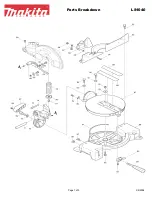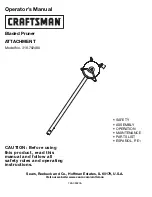
12
Horizontal Band Saw
The saw blade should also ride between the two roller
bearings (B) and (C) and the carbide blocks (E).
Use the adjusting screw (A) to lightly press the carbide
blocks against the surface of the blade.
The front and rear roller bearing guides are mounted to
eccentric shafts. Loosen the locking screws with a 6mm
hex wrench and turn the eccentric shaft with a 17mm open
end wrench until the bearing just contacts the blade. See
Fig. 11-3 Retighten the locking screw while holding the
eccentric shaft with the wrench to prevent it from turning.
Do this for both bearings then repeat for other guide
assembly.
IMPORTANT
: If bearing positions are properly set, they
should not be readjusted. Under daily operation and/
or normal maintenance, make adjustments using the
adjustment screws (A) to position the carbide guides
against the blade. Constant adjustment of the bearings
may aff ect longevity of the saw blade and cutting
accuracy.
11.5 CHANGING BLADE SPEED
1. Raise cutting head approximately six inches above
work piece and turn feed rate knob (O, Fig. 10-1) to
zero.
2. Turn power on and turn speed adjuster knob (see
L, Fig. 10-1) to match appropriate material. The
LED display will show the current speed. Consult a
machinery handbook for recommended speeds for
various materials.
11.4 ADJUSTING BLADE GUIDES
Proper adjustment of blade guide bearings is critical to
effi cient operation of the saw. The band saw is shipped
with the blade tensioned and blade guides properly set.
They will rarely require adjustment except after a blade
change. Failure to maintain proper blade guide settings
may cause inaccurate cuts and/or blade damage.
First verify that the blade is sharp and in good condition;
properly adjusted guides will not compensate for an
inferior blade.
Fig. 11-2 shows the left hand blade guide assembly;
Fig. 11-3 shows the right hand. Adjustments for both are
identical.
The back of the blade should ride against the upper
carbide guide (D, Fig. 11-3) which is positioned to provide
greater support and prevent defl ection at the back of the
blade.
Fig. 11-2
Fig. 11-3
11.6 ADJUSTING FEED RATE
Rate of feed is adjusted with control dial (O, Fig. 10-1).
Feed rate is important to band saw performance;
excessive pressure may break the blade or stall the saw.
Insuffi cient pressure rapidly dulls the blade.
Material chips and shavings are the best indicator of
proper feed pressure. The ideal chip is thin, tightly
curled, and warm to the touch. Chips that range from
golden brown to black indicate excessive force. Blue
chips indicate extreme heat from too high a blade speed;
this will shorten blade life. Thin, powdery chips indicate
insuffi cient feed pressure.
Summary of Contents for Elite ECB-1833DMEVS
Page 20: ...20 Horizontal Band Saw BASE ASSEMBLY ECB 1833DMEVS ...
Page 22: ...22 Horizontal Band Saw SWIVEL SEAT ASSEMBLY ECB 1833DMEVS ...
Page 26: ...26 Horizontal Band Saw SAW FRAME ASSEMBLY ECB 1833DMEVS ...
Page 28: ...28 Horizontal Band Saw GEAR BOX ASSEMBLY ECB 1833DMEVS ...
Page 30: ...30 Horizontal Band Saw MOVEABLE SEAT ASSEMBLY ECB 1833DMEVS ...
Page 32: ...32 Horizontal Band Saw LEFT SIDE GUIDE ASSEMBLY ECB 1833DMEVS ...
Page 34: ...34 Horizontal Band Saw RIGHT SIDE GUIDE ASSEMBLY ECB 1833DMEVS ...
Page 40: ...40 Horizontal Band Saw WIRE BRUSH ASSEMBLY ECB 1833DMEVS ...
Page 44: ...44 Horizontal Band Saw ELECTRICAL BOX DIAGRAM ECB 1833DMEVS ...
Page 46: ...46 Horizontal Band Saw 16 0 WIRING DIAGRAM ...
Page 47: ...47 ECB 1833DMEVS ...
Page 48: ...48 Horizontal Band Saw ...
Page 50: ...50 Horizontal Band Saw ...
Page 51: ...51 ECB 1833DMEVS NOTES ...
Page 52: ...52 Horizontal Band Saw ...













































